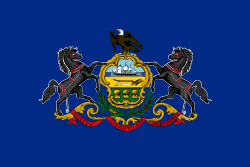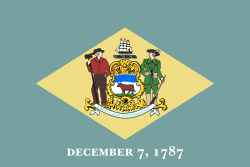Baltimore and Ohio Railroad
| Baltimore and Ohio Railroad | |
|---|---|
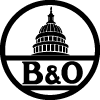 | |
|
B&O system map, circa 1961 | |
| Reporting mark | BO |
| Locale |
Illinois Indiana Ohio Pennsylvania West Virginia Maryland Virginia Delaware New Jersey New York |
| Dates of operation | 1828–1987 |
| Successor |
Chessie System CSX Transportation New York City Transit Authority |
| Track gauge | 4 ft 8 1⁄2 in (1,435 mm) standard gauge |
| Length | 5,658 miles (9,106 kilometres) |
| Headquarters | Baltimore, Maryland |
The Baltimore and Ohio Railroad (reporting mark BO) was the first common carrier and Class I railroad in the U.S. as well as one of the oldest. During its peak years, the railroad extended as far east as Staten Island, New York, and as far west as Illinois. Most surviving trackage is operated by CSX Transportation; trackage on Staten Island is operated by the Staten Island Railway as a branch of the New York City Transit Authority.[1]
History
19th century

The Baltimore & Ohio Railroad (B&O) was not the first railroad in the U.S., but it was the first common carrier railroad and the first to offer scheduled freight and passenger service to the public. It was the first intercity railroad in the United States. The most important American East Coast seaports in the early 1800s were Boston, New York City, Philadelphia, Baltimore, and Charleston, South Carolina.[2][3] Baltimore had an advantage in being farther inland than the others (and therefore closer to many markets), being located almost at the head of navigation on Chesapeake Bay, the estuary of the Susquehanna River. New York gained an advantage in 1825 with the opening of the Erie Canal, permitting navigation as far as Lake Erie, and in 1826 the Commonwealth of Pennsylvania chartered a system of canals to link Philadelphia with the Ohio River at Pittsburgh.
At the "Belvidere" estate just north of Baltimore, the Revolutionary War hero Col. John Eager Howard (1752-1827) met with several prominent city businessmen, merchants, shippers, and civic leaders to review the recent operations in Great Britain, as reported by Evan Thomas, brother of Philip E. Thomas, about the new revolutionary system of the Stockton and Darlington Railway and its chief engineer George Stephenson. Baltimore responded to the competition of the other cities and their canals by chartering the "Baltimore and Ohio Railroad Company of Baltimore City" on February 28, 1827.[4] The B&O was to build a railroad from Baltimore to a suitable point on the Ohio River.[2][5]:17,75[6]

Ground was broken for the railroad with great celebration on "Independence Day", July 4, 1828. The "first stone" was laid by 90-year-old Charles Carroll of Carrollton, the last surviving signer of the Declaration of Independence. A route was laid out to follow the upper Patapsco and Monocacy rivers to the Potomac, and work began.[7] The line was opened for scheduled service to Ellicott's Mills (later renamed Ellicott City) on May 24, 1830. The first vehicles to run on the railroad were horse-drawn coaches and wagons, but the railroad adopted steam power after the "Tom Thumb" was demonstrated on its track in August 1830. On December 1, 1831, the road was opened to Frederick, 60 miles (97 km). The B&O opened a branch from Relay Junction, Maryland (then also called Washington Junction) to Washington in August 1835, crossing the upper Patapsco River above Elkridge, Maryland on the curving, multi-spanned stone Thomas Viaduct, one of the B&O's and American railroading signature structures for 190 years. Two years later a wooden and iron-beamed bridge was completed across the Potomac to Harpers Ferry, West Virginia (then part of Virginia; the separation of the western portion of Virginia did not occur until 1863). At Harpers Ferry the B&O connected with the Winchester & Potomac Railroad, thus forming the first junction of two railroad companies in the U.S.[2] The line continued west through Cumberland, Maryland to Grafton, West Virginia, where it turned northwest to reach the goal of its charter at Wheeling, West Virginia, 379 miles (610 km) from Baltimore, on January 1, 1853, almost 25 years after commencing construction. Another line was pushed west from Grafton to reach the Ohio River at Parkersburg, West Virginia in 1856.[2][8]:441n47
The B&O was considered collateral damage during the American Civil War. Incompetent Union forces and leaders often failed to properly secure the region, despite the vital importance of the rail company to the Union cause.
"There is no interest suffering here except the Baltimore & Ohio Railroad and I will not divide my forces to protect it."— General Philip Sheridan[9]
This poor military strategy allowed Confederate commanders to lengthen the war by conducting free-ranging military operations against the region and railroad.
The B&O and its president John W. Garrett are particularly remembered for their part in the Battle of Monocacy. Agents of the railroad began reporting Confederate troop movements 11 days before the battle, and Garrett had their intelligence passed to authorities in the War Department and to Major General Lew Wallace, who commanded the department that would be responsible for defense of the area. As preparations for the battle progressed, the B&O transported federal troops and munitions, and President Abraham Lincoln twice asked Garrett for further information. Though Union forces lost the battle, it allowed Ulysses S. Grant to repel the Confederate attack on Washington at the Battle of Fort Stevens two days later. After the battle, Lincoln paid tribute to Garrett, saying "The right arm of the Federal Government, in the aid he rendered the authorities in preventing the Confederates from seizing Washington; securing its retention as the Capital of the Loyal States."[10] The following prominent raids involving the B&O took place:
- Great Train Raid of 1861: May 22 – June 23, 1861
- Romney Expedition: January 1–24, 1862
- Operations during the Maryland Campaign: September 8, 1862
- Jones-Imboden Raid: April 24 – May 22, 1863
- Catoctin Station Raid: June 17, 1863
- First Calico Raid: June 19, 1863
- B&O Raid on Duffield Station: January 1864
- McNeill Raid: May 5, 1864
- Second Calico Raid: July 3, 1864
- Battle of Monocacy: July 9, 1864
- Gilmor's Raid: July 11, 1864
- Greenback Raid, by Mosby's Rangers: October 14, 1864
- B&O Raid on Duffield Station II: January 1865
- Gilmor's B&O Raid: February,1865
- B&O Derailment Raid: March, 1865
B&O locomotives captured during the Great Train Raid of 1861 Engine Type No. 17 Norris 4-2-0 No. 34 Mason 4-4-0 No. 187 Camelback 0-8-0 No. 188
(CSA name "Lady Davis")Tyson 4-4-0 "Dutch Wagon" No. 193 Camelback 0-8-0 No. 198 Hayes Camelback 0-8-0 No. 199 Camelback 0-8-0 No. 201 ?
After the end of the war, B&O continued westward in 1866 by leasing the Central Ohio Railroad, a line from Bellaire, Ohio, across the Ohio River from Wheeling, through Newark to Columbus, and in 1869 by leasing a line from Newark to Sandusky, Ohio. From a point on that line called Chicago Junction (now Willard) a subsidiary company, the Baltimore & Ohio & Chicago, built west to Chicago between 1872 and 1874.[2]
Under Garrett's leadership, the B&O expanded in several directions at once. In 1871 the Pittsburgh & Connellsville Railroad completed a Cumberland-Pittsburgh line and leased it to the B&O the following year. The Metropolitan Branch, from Washington to a connection with the main line at Point of Rocks, Maryland, was opened in 1873.[11]
As a result of poor national economic conditions in the mid-1870s following the Panic of 1873, the B&O attempted to reduce its workers' wages. After a second reduction in wages was announced in the same year, workers began the Great Railroad Strike of 1877, on July 14, in Martinsburg, West Virginia. The strike spread to Cumberland, and when the governor of Maryland, on July 20, attempted to put down the strike by sending the state militia from Baltimore, riots broke out resulting in 11 deaths, the burning of parts of Camden station, and damage to several engines and cars.[12] The next day workers in Pittsburgh staged a sympathy strike that was also met with an assault by the state militia; Pittsburgh then erupted into widespread rioting. The strike ended after federal troops and state militias restored order.
The line into Pittsburgh put B&O into Pennsylvania Railroad (PRR) territory, and even in 1871, the PRR was something of a bully. Washington-New York passenger service in the 1870s was operated jointly by the B&O between Philadelphia and Jersey City. In 1872, the PRR built a line of its own from Baltimore to Washington. B&O rerouted its trains off the PRR to the Reading Railroad (RDG)/Central Railroad of New Jersey (CNJ) route between Philadelphia and Jersey City (known as the "B-R-J" route)[13] and proposed to construct terminal facilities of its own on Staten Island. Both B&O and PRR wanted control of the Philadelphia, Wilmington & Baltimore Railroad (PW&B) — PRR managed to get it in 1881. B&O set out to build its own line — the Philadelphia Subdivision — from Baltimore to Philadelphia, parallel to the PW&B and no more than a few miles from it. PRR responded in 1884 by refusing to handle B&O trains east of Baltimore. B&O opened its new line to Philadelphia in 1886.[2]
Garrett died in 1884 and was succeeded by his son Robert for two years, Samuel Spencer for one, and then Charles F. Mayer. Mayer undertook to improve the railroad and at the same time, keep its financial situation from crumbling. The most significant improvements were control of the Pittsburgh & Western Railroad (Pittsburgh-Akron), construction of a line from Akron, Ohio, to Chicago Junction; control of a route from Parkersburg, West Virginia, through Cincinnati to St. Louis (the Baltimore & Ohio Southwestern, which included the former Ohio & Mississippi Railway, completed in 1857); construction of a line through, around, and under Baltimore to connect the Philadelphia route with the rest of the B&O; and electrification of the Baltimore Belt, the first mainline electrification in North America.[2][14]
The financial situation was more difficult. The B&O had a large debt. Freight and passenger rates were low and revenues were dropping — in 1889 B&O handled 31 percent of the country's tidewater soft coal traffic; in 1896, that had dropped to just 4 percent because of competition from other railroads. The B&O cut back on expenditures for maintenance and quickly acquired a reputation for unreliability. The Panic of 1893 was well underway, and business was in bad shape nationwide. B&O entered receivership in 1896.[2]
20th century
B&O came out of receivership in 1899 still under its original charter, which included tax exemption privileges. In 1901 the PRR managed to buy a large block of B&O stock and appoint Leonor F. Loree president of the railroad. Loree undertook a line improvement program that reduced grades and curves and added many miles of double track, and he secured for B&O a large interest in the RDG, which in turn controlled the CNJ. The PRR sold some of its B&O stock to the Union Pacific Railroad (UP) in 1906 and traded the remainder to UP for the Southern Pacific stock in 1913. UP eventually distributed its B&O stock as a dividend to its own stockholders.[2] Oscar G. Murray was president of the B&O when the majestic B&O Railroad Headquarters Building was completed in 1906. The previous structure burnt down in the Great Baltimore Fire of 1904.
Daniel Willard became president of the B&O in 1910. More than anyone else he is responsible for the company's conservative, courteous personality in the mid-twentieth century. Further expansion included the purchase in 1910 of the Chicago Terminal Transfer Railroad, a belt line that was renamed the Baltimore & Ohio Chicago Terminal Railroad; the acquisition in 1917 of the Coal & Coke Railway from Elkins to Charleston, West Virginia; and acquisition that same year of portions of the Cincinnati, Hamilton & Dayton Railway and its leased lines to form a route from Cincinnati to Toledo.[2]
_train.jpg)
In 1927 B&O celebrated its centennial with the Fair of the Iron Horse, a pageant and exhibition at Halethorpe, Maryland. Much of the rolling stock exhibited there was from B&O's museum collection, which formed the nucleus of the B&O Railroad Museum in Baltimore, one of the earliest railroad museums.[2]
The Interstate Commerce Commission (ICC) merger plan of the 1920s put B&O into an expansionist mood. In 1926 B&O purchased the Cincinnati, Indianapolis & Western Railroad's line from Hamilton, Ohio to Springfield, Illinois. In 1927 it acquired an 18 percent interest in the Wheeling & Lake Erie Railway (W&LE) and began to purchase Western Maryland Railway (WM) stock. In 1929 B&O bought the Chicago & Alton, reorganized it as the Alton Railroad, and operated it as part of the B&O. (Alton regained independence in 1943 and merged with the Gulf, Mobile & Ohio Railroad in 1947.) In 1932 B&O acquired the Buffalo, Rochester & Pittsburgh Railway from the Van Sweringen brothers in exchange for its interest in the W&LE and also purchased the Buffalo & Susquehanna Railroad. In 1934 B&O arranged for trackage rights on the Pittsburgh & Lake Erie Railroad's (P&LE) water-level route between McKeesport and New Castle, Pennsylvania, bypassing the curves and grades of its own route (which remained in service for local business). B&O's through passenger trains moved to P&LE's Pittsburgh station across the Monongahela River from the B&O station.[2]

In the first half of the twentieth century the B&O ran commuter rail operations out of Baltimore, Pittsburgh and Washington, D.C.
For many years the B&O competed with the PRR and New York Central Railroad (NYC) in the New York-Chicago and New York-St. Louis passenger markets and with PRR on the New York-Washington run. B&O's trains were slower, partly because of their longer route through Washington, but they were dieselized a decade before the competition. Many preferred B&O's New York-Washington trains to PRR's, but the most frequently stated reason for preferring B&O — "You could always get a seat" — was the reason B&O dropped its passenger service east of Baltimore in April 1958. Also, the PRR had the advantage of running trains directly into New York City's Manhattan Island. The B&O trains terminated in the Central Railroad of New Jersey Terminal in Jersey City, requiring passengers to take a ferry across the Hudson River. The B&O operated a special bus service by which buses picked up passengers in Manhattan and drove passengers directly onto the ferry.[13]
In 1960 the Chesapeake & Ohio Railway (C&O) began to acquire B&O stock. NYC made a bid, but B&O's stockholders approved C&O control, and on May 1, 1962, so did the ICC. By early 1964 C&O owned 90% of B&O's stock. In 1967 the ICC authorized C&O and B&O to control WM; B&O's WM stock had long been held in a nonvoting trust. On June 15, 1973, B&O, C&O, and WM were made subsidiaries of the newly created Chessie System, although they continued to operate as separate railroads. There was no great surge of track abandonment, because in most areas B&O and C&O were complementary rather than competitive. In 1981 B&O leased the former Rock Island trackage from Blue Island to Henry, Illinois.[2]
B&O continued to exist with the Chessie System. On May 1, 1983, B&O assumed operations of the WM. Four years later, on April 30, 1987, C&O merged B&O, and four months after that, CSX Transportation merged C&O.[15]
| B&O | SIRT | BR&P | CI&W | D&U | ICV | |
|---|---|---|---|---|---|---|
| 1925 | 19459 | 6 | 1585 | 376 | 3 | 15 |
| 1933 | 12111 | 6 | (included in B&O) | (included in B&O) | (included in B&O) | (included in B&O) |
| 1944 | 34802 | 9 | ||||
| 1960 | 24840 | 15 | ||||
| 1970 | 28594 | ? |
| B&O | SIRT | BR&P | CI&W | D&U | ICV | |
|---|---|---|---|---|---|---|
| 1925 | 878 | 67 | 47 | 14 | 0.004 | 0.1 |
| 1933 | 435 | 52 | (included in B&O) | (included in B&O) | (included in B&O) | (included in B&O) |
| 1944 | 2758 | 81 | ||||
| 1960 | 533 | 37 | ||||
| 1970 | 64 | ? |
Industry firsts
Innovations
B&O invented many new managerial methods that became standard practice in railroading and modern business. B&O became the first company to operate a locomotive built in America, with the "Tom Thumb" in 1829. It built the first passenger and freight station (Mount Clare in 1829) and was the first railroad that earned passenger revenues (December 1829), and published a timetable (May 23, 1830). On December 24, 1852, it became the first rail line to reach the Ohio River from the eastern seaboard.[5]
First telegraph line
In 1843, Congress appropriated $30,000 for construction of an experimental 38-mile (61 km) telegraph line between Washington, D.C., and Baltimore along the B&O's right-of-way. The B&O approved the project with the agreement that the railroad would have free use of the line upon its completion. An impressive demonstration occurred on May 1, 1844, when news of the Whig Party's nomination of Henry Clay for U.S. President was telegraphed from the party's convention in Baltimore to the Capitol Building in Washington. On May 24, 1844, the line was officially opened as Samuel F. B. Morse sent his famous words "What hath God wrought" from the B&O's Mount Clare station to the Capitol Building along the wire.[5]:59–60
Engineering

When construction began on the B&O, railroad engineering was in its infancy. Unsure exactly which materials would suffice, the B&O erred on the side of sturdiness and built many of its early structures of granite. Even the track bed to which iron strap rail was affixed consisted of the stone.
Though the granite soon proved too unforgiving and expensive for track, most of the B&O's monumental bridges have survived to this day, and many are still in active railroad use by CSX. Baltimore's Carrollton Viaduct, named in honor of Charles Carroll of Carrollton, was the B&O's first bridge, and is the world's oldest railroad bridge still carrying trains (world's oldest railway bridge is Causey Arch, UK). The Thomas Viaduct in Elkridge, MD was the longest bridge in the United States upon its completion in 1835, and remains in use as well. The B&O made extensive use of the Bollman iron truss bridge design in the mid-19th century. Its durability and ease of assembly aided faster railroad construction.
As the B&O built the main line west to Parrs Ridge, it had limited information about the operation of steam locomotives. Consequently the company was uncertain if the engine's metal wheels would grip the metal rails sufficiently to pull a train up to the top of the ridge. The railroad decided to construct two inclined planes on each side of the ridge along which teams of horses, and perhaps steam-powered winches, would assist pulling the trains uphill. The planes, about a mile long on each side of the ridge, quickly proved an operational bottleneck, and before the decade of the 1830s ended the B&O built a 5.5-mile (8.9 km) long alternate route that became known as the Mount Airy Loop. The planes were quickly abandoned and forgotten, though some artifacts survive to the present.
In popular culture
- The B&O is one of four railroad properties players can own in the Parker Brothers game Monopoly.
- Fanny Brice (Barbra Streisand) rides a train labeled "B&O R.R." in the musical Funny Girl.
Named cars
Gallery
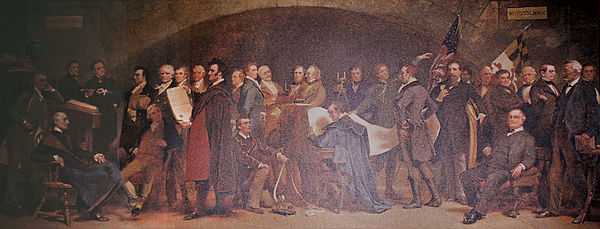
>
-

The Allegheny Mountains were a formidable barrier, even to Amerindian travelers
-
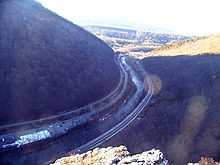
Cumberland Narrows
-

Advertisement for B&O in an 1864 Baltimore city directory, promoting its repairs and reopening at one point during the Civil War
-

Table of Cumberland Coal shipped over B&O Railroad and C&O Canal, 1842–1865
-

B&O system map, circa 1891
-

Blockade of engines at Martinsburg, West Virginia during 1877 strike
-

B&O system map, circa 1876
-

B&O stock certificate, 1903
-
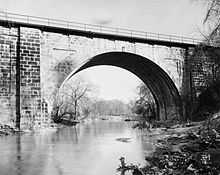
Carrollton Viaduct
-
_train.jpg)
B&O's Columbian crossing the Potomac River at Harpers Ferry, West Virginia, 1949
-

B&O headquarters building on North Charles Street, Baltimore
-
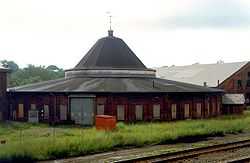
B&O roundhouse complex, Martinsburg, West Virginia
-
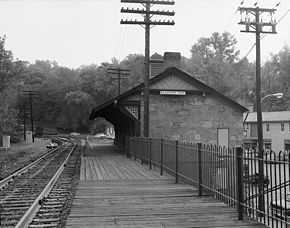
Ellicott City Station, Maryland
-
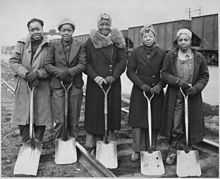
Trackwomen during WWII
-
Commemorative stamp, issued on 125th anniversary of the B&O, 1952
-

Slate quarry at Ijamsville, Maryland with B&O tracks in foreground, c. 1898

See also
- B&O locomotives
- B&O Martinsburg Shops
- B&O Railroad Museum
- Aeolus Railroad Car
- Old Main Line Subdivision
- Baltimore Terminal Subdivision
- Pope's Creek Subdivision
- Camden Station
- Mount Royal Station
- Mount Clare Shops
- Charles T. Hinde
- Capital Crescent Trail
References
- ↑ nycsubway.org
- ↑ 2.0 2.1 2.2 2.3 2.4 2.5 2.6 2.7 2.8 2.9 2.10 2.11 2.12 Drury, George H. (1994). The Historical Guide to North American Railroads: Histories, Figures, and Features of more than 160 Railroads Abandoned or Merged since 1930. Waukesha, Wisconsin: Kalmbach Publishing. pp. 35–40. ISBN 0-89024-072-8.
- ↑ An 1827 report shows the motivations of early boosters:
Woody, William (1827). "Baltimore and Ohio Railroad. Proceedings of sundry citizens of Baltimore, convened for the Purpose of Devising the most efficient Means of Improving the Intercourse between that City and the Western States". The North American Review (Boston: Frederick T. Gray) 25 (56): 62–73. - ↑ "The Economic History of the Baltimore and Ohio Railroad 1827-1853" Page 15, 1882
- ↑ 5.0 5.1 5.2 Stover, John F. (1987). History of the Baltimore and Ohio Railroad. West Lafayette, IN: Purdue University Press. ISBN 0-911198-81-4.
- ↑ Moody, John (1919). "Crossing the Appalachian Range". The Railroad Builders, A Chronicle of the Welding of the States. Chronicles of America Series, Vol. 38. New Haven, Connecticut: Yale University Press. Retrieved April 6, 2006.
- ↑ Lynch, John A. "Justice Douglas, the Chesapeake & Ohio Canal, and Maryland Legal History". University of Baltimore Law Forum 35 (Spring 2005): 104, 112–125.
- ↑ Dilts, James D. (1996). The Great Road: The Building of the Baltimore and Ohio Railroad1828–1853. Palo Alto, CA: Stanford University Press. ISBN 978-0-8047-2629-0.
- ↑ Ramage, p. 206
- ↑ "John W. Garrett, President, B & O Railroad." U.S. National Park Service, Monocacy National Battlefield, Frederick, MD. Accessed 2005-11-14.
- ↑ Soderberg, Susan C. (1998). The Met: A History of the Metropolitan Branch of the B&O Railroad, Its Stations and Towns. Germantown, MD: Germantown Historical Society. p. 10.
- ↑ Scharf, J. Thomas, History of Maryland From the Earliest Period to the Present Day, vol. 3 pages 733–42, Heritage Press: Hatboro, Pa., 1967 (reissue of 1879 edition)
- ↑ 13.0 13.1 Pawson, John R. (1979). Delaware Valley Rails: The Railroads and Rail Transit Lines of the Philadelphia Area. Willow Grove, Pennsylvania: John R. Pawson. p. 24. ISBN 0-9602080-0-3.
- ↑ Ferneyhough, Frank (1975). The History of Railways in Britain. Reading: Osprey. ISBN 0-85045-060-8.
- ↑ Volin, Rudy (July 6, 2006). "Perryville and Havre de Grace, Md.". Trains. Retrieved March 10, 2009.
Further reading
- Harwood, Jr., Herbert H. (1994). Impossible Challenge II: Baltimore to Washington and Harpers Ferry from 1828 to 1994. Baltimore: Barnard, Roberts. ISBN 0-934118-22-1.
- Ramage, James A., Gray Ghost: The Life of Colonel John Singleton Mosby. University Press of Kentucky, 1999.
- Sagle, Lawrence, and Alvin Staufer. B&O Power, Alvin F. Staufer, 1964.
External links
| Wikimedia Commons has media related to Baltimore and Ohio Railroad. |
| Wikisource has original text related to this article: |
| ||||||
- Baltimore & Ohio Railroad Museum
- 1827 report shows motivations of early boosters
- John W. Garrett Collection, 1850–1880 Archives Center, National Museum of American History, Smithsonian Institution.
- The Baltimore and Ohio Railroad Network
- Maryland Railroads as of 1850
- Virginia (and West Virginia) Railroads as of 1850
- Mileposts from CSX Transportation Timetables
- List and Family Trees of North American Railroads
- B&O Whistles, Whistle museum
- Baltimore and Ohio Rail Road Station From Walnut Street Wharf Schuylkill River, June 29, 1889 by D.J. Kennedy, Historical Society of Pennsylvania
- The 1977-1978 Chessie Steam Special for the B&O's 150th Anniversary
- Photographic views of the Baltimore and Ohio Rail Road and its branches from the lakes to the sea This book, published in 1872, is illustrated with photographic images of attractions found along the route of the Baltimore and Ohio Railroad between Baltimore and Chicago, including Baltimore's harbor, the U.S. Capitol, bridges, viaducts, depots, roundhouses, rivers, towns, and cities.
- Historic American Engineering Record documentation:
- HAER No. MD-51, "Baltimore & Ohio Railroad, Tobacco Warehouse, 1000-1001 Fell Street, Baltimore, Independent City, MD", 27 photos, 5 data pages, 2 photo caption pages
- HAER No. WV-22, "Baltimore & Ohio Railroad, Keyser Machine Shop, State Route 46 Northwest of Spring Street, Keyser, Mineral County, WV", 11 photos, 4 data pages, 2 photo caption pages
- HAER No. WV-91, "Baltimore & Ohio Railroad, Z Tower, State Route 46, Keyser, Mineral County, WV", 19 photos, 2 photo caption pages
| ||||||||
| |||||||||||||||||||||||||
| |||||||||||||||||||||



